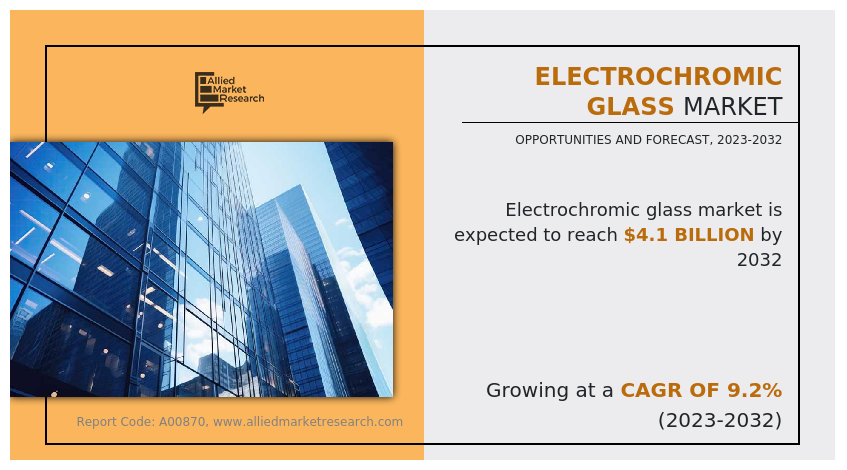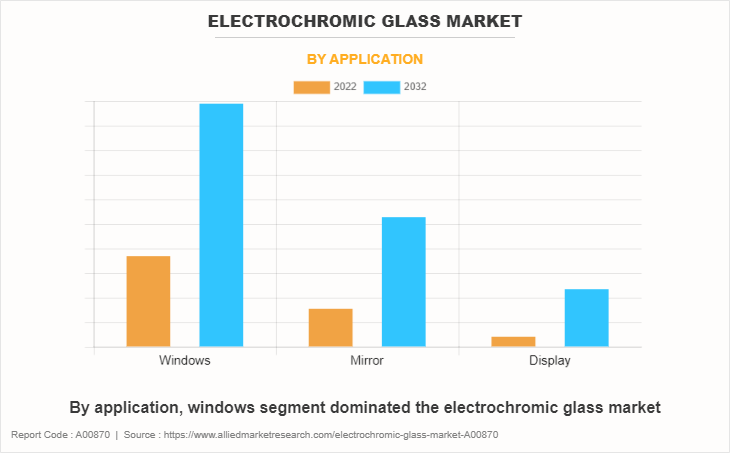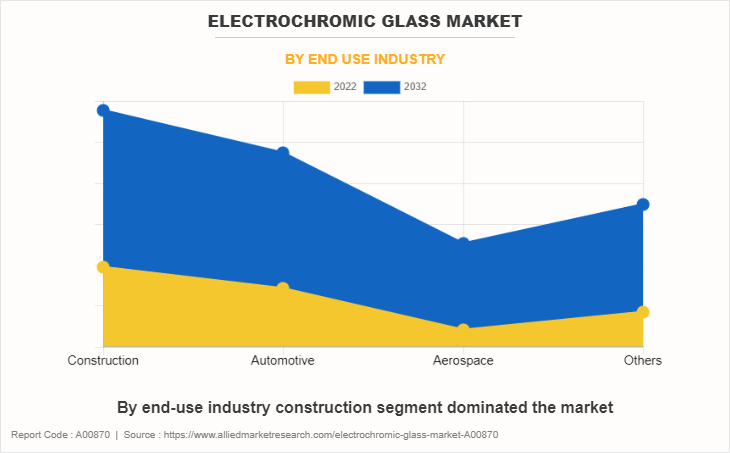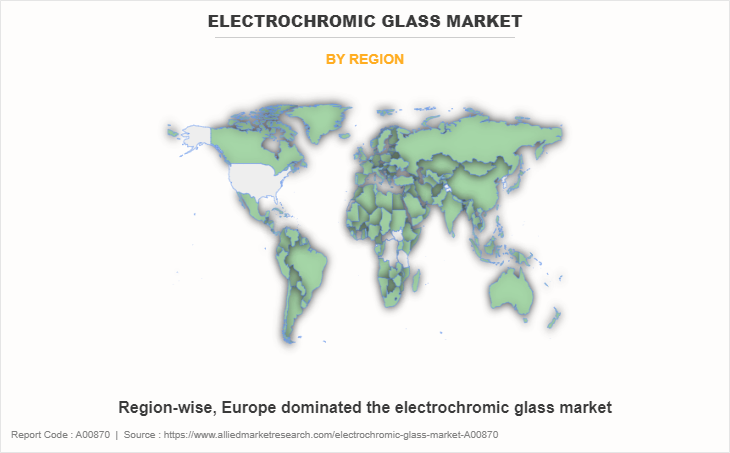Electrochromic Glass Market Research, 2032
The global electrochromic glass market size was valued at $1.7 billion in 2022, and is projected to reach $4.1 billion by 2032, growing at a CAGR of 9.2% from 2023 to 2032.
Report Key Highlighters:
- The electrochromic glass market scope covers 20 countries. The research includes a segment analysis of each country in terms of value ($million) for the projected period 2023-2032.
- The study integrated high-quality data, professional opinions and analysis, and critical independent perspectives. The research approach is intended to provide a balanced view of global markets and to assist stakeholders in making educated decisions in order to achieve their most ambitious growth objectives.
- Over 3,700 product literature, annual reports, industry statements, and other comparable materials from major industry participants were reviewed to gain a better understanding of the market.
- The electrochromic glass market share is highly fragmented, with several players including AGC Inc., ChromoGenics AB, Saint-Gobain S.A., SAGEGLASS, Pleotint LLC, Polytronix, Inc., Gentex Corporation, Guardian Industries Corporation, Suntuitive Glass, and, View, Inc.. Also tracked key strategies such as acquisitions, product launches, mergers, expansion etc. of the players operating in the electrochromic glass market.

Electrochromic glass, often referred to as smart glass or switchable glass, is a specialised type of glass that has the remarkable property of changing its transparency or opacity when an electrical voltage is applied. This transformation is carried out through the electrochromic effect, where the glass changes color or becomes extra or less translucent in response to an electric powered current. This technology lets in dynamic manipulate over the amount of light, heat, and glare that enters a space, supplying severa benefits in terms of energy efficiency and person comfort.
Electrochromic glass market has found a valuable area in the automobile industry. It is used for sunroofs, rearview mirrors, and facet home windows in high-end vehicles. The capacity to manipulate the degree of tint in these areas enhances driver comfort and safety. Electrochromic mirrors mechanically dim to reduce glare from headlights of motors behind, while sunroofs get adjusted to stop excessive sunlight and warmth from coming into the cabin. This technology contributes to a higher riding experience.
Electrochromic science has made its way into patron electronics as well. Some e-readers and smartphones function electrochromic displays. These gadgets use electrochromic substances to create displays that mimic the look of paper, making them simpler on the eyes and extra readable in vibrant sunlight. The capability to exchange the screen's reflective homes is a testomony to the versatility of electrochromic materials.
In addition to power efficiency, electrochromic glass serves privacy and security functions. In workplaces and assembly spaces, it switches from transparent to opaque with a easy electrical signal. This characteristic ensures that touchy discussions and private meetings are carried out with a greater degree of privacy. Furthermore, in residential applications, it offers an extra layer of security by using obstructing the view into the constructing from the outside.
In healthcare facilities and laboratories, electrochromic glass is utilized for controlling the transparency of windows and partitions.
This dynamic control of electrochromic glass mainly beneficial in environments where both privacy and visibility are essential. For example, in a hospital, it is used in patient rooms to maintain patient privateness while allowing medical staff to screen the patient as needed. The retail and hospitality industries have embraced electrochromic glass. Storefronts use it to create eye-catching displays that transition from opaque to transparent, allowing products to be concealed or revealed at the push of a button. In hotels and restaurants, electrochromic glass is used to create intimate dining areas within an open floor plan, imparting flexibility and ambiance to customers.
The growth of smart buildings and the Internet of Things (IoT) drives electrochromic glass market growth.
Electrochromic glass, known as smart glass, has received importance in the context of smart buildings and the Internet of Things (IoT). This technology allows the dynamic control of light and heat entering a building, leading to expanded energy effectivity and comfort. In clever building systems, electrochromic glass is built-in to optimize lights and temperature based on factors such as occupancy and weather conditions. It mechanically adjusts its tint to limit the need for blinds or shades, enhancing both aesthetics and energy efficiency. In February 2022, Gauzy, an Israeli smart glass technology provider, acquired Vision Systems, a French company, to expand its offerings and enter the Advanced Driver Assistance System (ADAS) industry the use of Vision Systems' camera-based image evaluation and monitoring solutions.
The high cost of electrochromic glass industry is expected to hinder growth during the forecast period. Installing and integrating electrochromic glass into existing buildings is quite expensive. Retrofitting involves substantial modifications to support electrical systems and smart glass controls, driving up material and labor costs. Architectural changes and additional support structures are necessary, adding to the expenses. In addition, ongoing maintenance is required, albeit less costly than the initial purchase, contributing to the total cost of ownership.
The electrochromic glass market is segmented into application, end-use industry, and region. On the basis of application, the market is divided into windows, mirror, and display. Depending on end-use industry, the market is classified into construction, automotive, aerospace, and others. Region-wise, the market is studied across North America, Europe, Asia-Pacific, and LAMEA.

As the temperature and amount of sunshine change, electrochromic windows have the capability to change their tint or opacity. Buildings with dynamic and modern designs are made with electrochromic glass. A building's aesthetic attractiveness is multiplied by applying it on partitions, skylights, and facades. Energy efficiency and comfort is maximized by integrating them with different building systems, such as heating, ventilation and air conditioning (HVAC) and lighting.

Electrochromic glass blocks a significant quantity of detrimental UV rays, which help defend indoors furnishings and artwork from fading. In development of conference rooms or bedrooms, electrochromic glass be used for privacy and to reduce glare from outside. Users modify the tint to their preference, maintaining privateness without sacrificing herbal light. Using electrochromic glass to adjust building temperature and lights leads to reduced energy consumption, making it an environmentally friendly choice.

Electrochromic glass is utilized in modern European buildings to manage natural mild and heat, reducing the need for artificial lighting and air conditioning for energy efficiency. In addition, it is employed in international locations with rich architectural heritage such as Italy and France to guard historical constructions and artworks by controlling mild and UV radiation, preserving treasured artifacts and interiors. Moreover, some European artists and designers have integrated electrochromic glass into interactive art installations that respond to environmental prerequisites or user interactions.
The major players operating in the electrochromic glass market include AGC Inc., ChromoGenics AB, Saint-Gobain S.A., SAGEGLASS, Pleotint LLC, Polytronix, Inc., Gentex Corporation, Guardian Industries Corporation, Suntuitive Glass, and, View, Inc.
Apart for the above mentiond companies there are many companies those who manufacture electrochromic glass including (Smartglass International, Halio, Gauzy, Hitachi Chemical Co., Ltd., InvisiShade, Topray Solar, Asahi Glass Co., Ltd., Citala, G-Cube, Innovative Glass Corp., LTI Smart Glass Inc., Mirai Industry Co., Ltd., Pleotint, Polytronix, Inc., SPD Control Systems, The Smart Glass Company, VarioGlass Inc., Yantai Rushui Optoelectronics Technology Co., Ltd., Zunum Aero and others).
Historic trends of electrochromic glass market:
- In 1960s, research on electrochromic materials began. Early studies discover the electrochromic homes of tungsten oxide (WO3) and other transition steel oxides.
- In 1973, the first patent for electrochromic glass was certainly granted to Harold J. Byker. He is often credited with pioneering technology and performed a vast function in the early development of electrochromic materials and their applications.
- In the 1980s, significant advancements in electrochromic technological know-how led to practical applications, and one of the notable uses used to be in the automotive industry for rearview mirrors. The improvement of electrochromic rearview mirrors represented a breakthrough in automotive protection and convenience.
- In the 1990s, electrochromic windows started out to gain popularity in both architectural and automotive applications. These innovative windows supplied dynamic manipulate of daylight and privacy.
- In the 2000s, R&D efforts in the subject of electrochromic glass led to huge advancements, specially in terms of improved performance and elevated energy efficiency. Electrochromic glass noticed increased adoption in architectural applications, such as windows for commercial and residential buildings.
- In 2010s, the adoption of electrochromic glass in energy-efficient constructing designs became extra enormous due to its capacity to reduce photo voltaic heat acquire and improve indoor comfort. Electrochromic glass is increasingly used in smart residences and commercial buildings, with the capacity to be controlled electronically and integrated into building automation systems.
Key Benefits For Stakeholders
- This report provides a quantitative analysis of the market segments, current trends, estimations, and dynamics of the electrochromic glass market analysis from 2022 to 2032 to identify the prevailing electrochromic glass market opportunities.
- The market research is offered along with information related to key drivers, restraints, and opportunities.
- Porter's five forces analysis highlights the potency of buyers and suppliers to enable stakeholders make profit-oriented business decisions and strengthen their supplier-buyer network.
- In-depth analysis of the electrochromic glass market forecast to determine the prevailing market opportunities.
- Major countries in each region are mapped according to their revenue contribution to the global market.
- Market player positioning facilitates benchmarking and provides a clear understanding of the present position of the market players.
- The report includes the analysis of the regional as well as global electrochromic glass market trends, key players, market segments, application areas, and market growth strategies.
Electrochromic Glass Market Report Highlights
| Aspects | Details |
| Market Size By 2032 | USD 4.1 billion |
| Growth Rate | CAGR of 9.2% |
| Forecast period | 2022 - 2032 |
| Report Pages | 219 |
| By Application |
|
| By End Use Industry |
|
| By Region |
|
| Key Market Players | SAGEGLASS, Polytronix, Inc., ChromoGenics, RavenWindow, PLEOTINT LLC, GENTEX CORPORATION, View, Inc., Saint-Gobain, AGC Inc., Guardian Industries |
Analyst Review
According to the opinions of various CXOs of leading companies, the global electrochromic glass market was dominated by the construction segment. Electrochromic glass is a key component of daylight harvesting systems. These systems optimize the use of natural light by automatically adjusting the glass to control glare and heat gain. This enhances indoor comfort and minimizes the need for electric lighting.
The increase in usage of electrochromic glass in automotive sunroofs and windows drives the growth of the electrochromic glass market during the forecast period. The electrochromic glass allows drivers and passengers to adjust the tint of the windows and sunroof, reducing glare and heat from direct sunlight. This enhances driving comfort and safety. The sleek appearance of smart glass in automotive applications enhances the overall aesthetics of the vehicle. Electrochromic glass technology enhances the overall user experience and be integrated with the vehicle's electronics for easy control.
However, the high cost of electrochromic glass is expected to restrain industry expansion. Electrochromic glass is more expensive than traditional glass due to its complex manufacturing process, involving costly materials and specialized techniques. The installation and integration of electrochromic glass into existing structures also be expensive, as it often requires significant modifications for electrical systems and controls, making it less appealing for many building projects.
The Europe region is projected to register robust growth during the forecast period. Many European countries have integrated electrochromic glass into smart building systems. These systems automatically adjust the tint of the glass based on real-time weather conditions and sunlight exposure, ensuring a comfortable indoor environment and less energy consumption.
The global electrochromic glass market was valued at $1.7 billion in 2022, and is projected to reach $4.1 billion by 2032, growing at a CAGR of 9.2% from 2023 to 2032.
The report covers profiles of key industry participants such as AGC Inc., ChromoGenics AB, Compagnie de Saint-Gobain S.A., Kinestral Technologies INC., Pleotint LLC, Polytronix, Inc., Showa Denko, Guardian Industries Corporation, Suntuitive Glass, and, View, Inc.
The electrochromic glass market is segmented into application, end-use industry, and region. On the basis of application, the market is divided into windows, mirror, and display. Depending on end-use industry, the market is classified into construction, automotive, aerospace, and others.
The leading application of electrochromic glass market are windows, mirror, and display.
Based on end-use industry construction segment dominated the market.
Europe is the largest region for electrochromic glass market.
The demand for green building certifications is the upcoming trends of electrochromic glass market in the world.
Loading Table Of Content...
Loading Research Methodology...


